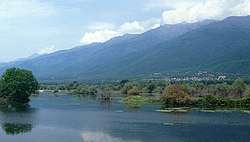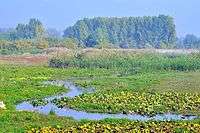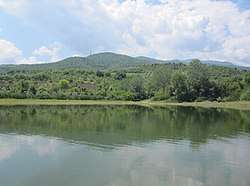Lake Kerkini
Lake Kerkini (Greek: Λίμνη Κερκίνη), is an artificial reservoir in Central Macedonia, Greece that was created in 1932, and then redeveloped in 1980, on the site of what was previously an extremely extensive marshland.
| Lake Kerkini | |
|---|---|
 | |
| Coordinates | 41.21°N 23.13°E |
| Type | reservoir |
| Primary inflows | Strymon River |
| Primary outflows | Strymon River |
| Basin countries | Greece |
| Max. length | 17 kilometers (11 mi) |
| Max. width | 5 kilometers (3.1 mi) |
| Surface area | 75 square kilometers (29 sq mi) |
| Max. depth | 35.5 m (116 ft) |
| Surface elevation | 35 meters (115 ft) |
| Official name | Artificial Lake Kerkini |
| Designated | 21 August 1975 |
| Reference no. | 58[1] |

Lake Kerkini is now one of the pemier birding sites in Greece and, as it is situated along the migratory flyway for migratory birds en route to the Aegean Sea, the Balkan region, the Black Sea, the Hungarian steppes and beyond it experiences an interesting migration.
History
Before 1932, there were irregular marsh lakes on Strymon, one of them called "Podkova" (from Slavic origin, in Bulgarian and Macedonian "Podkova" meaning "Horseshoe", found in Ottoman Turkish records: ݒودقوه كولي Podkova Gölü.[2]). The lake was created where Kerkini lake was by making embankments on the eastern and western sides and a dam was constructed near the village of Lithotopos, which started functioning in 1932. After the construction of the dam, the form of the initial hydrobiosphere changed completely.
As time went by, the lake's capacity was reduced because of the substances that were washed up by Strymon river. So the rising of the embankments and the construction of a new dam was necessary, which was started operating in 1982.
Geography
The main water provider of the lake is Strymon River. Additionally, there is Kerkinitis river from Krousia that flows into the lake.
In the flat and semi-mountainous area, important hydrobiospheres are developing which are of great international significance and acceptance. The most essential hydrobiosphere is the one in Kerkini lake. It is a miracle of nature which came about by man's technical intervention on the natural characteristics of Strymon river. The water extent, which varies from time to time from 54 Km2 to 72 Km2, works out to be useful in two ways: as a technical work of great agricultural utility and as a hydrobiosphere for thousands of water fowls.
Nature
This biosphere is recouped by the International Convention of Ramsar and presents numerous admirable elements. Thousands of birds, both rare and protected, riverside forests, water-lilies in a large area, fish variety and fantastic panoramic view from the mountains of Belasica and Krousia give it a characteristic tone. Actually the lake hosts 227 kinds of birds, especially non-migrants. 76 of them are recorded in the National Red Catalogue, while at least 31 of them are protected by EEC's Directive concerning wild life. What makes an exceptional presence is the buffalo's herd in the area, plus the one of the jackelo in the area of Kerkini lake. In the surrounding area of Kerkini lake there are at least 10 amphibian species (frogs, salamanders, tritons), five snail species, 19 reptile species (lizards, snakes, turtles) and a great variety of insects which play an important part in the food chain and contribute towards the biological resources of the lake.
The human intervention usually retracts or takes negative action against the natural processes, Kerkini lake is a rare example, where the gentle human handling had the exact opposite result.
Gallery
 Krousia mount from the lake
Krousia mount from the lake Flamingo birds in the lake
Flamingo birds in the lake White pelicans at the lake
White pelicans at the lake Buffalos at the lake
Buffalos at the lake View
View View
View- The dam of Lake Kerkini
References
- "Artificial Lake Kerkini". Ramsar Sites Information Service. Retrieved 25 April 2018.
- http://pds.lib.harvard.edu/pds/view/4952983?n=17
External links
| Wikimedia Commons has media related to Kerkini Lake. |